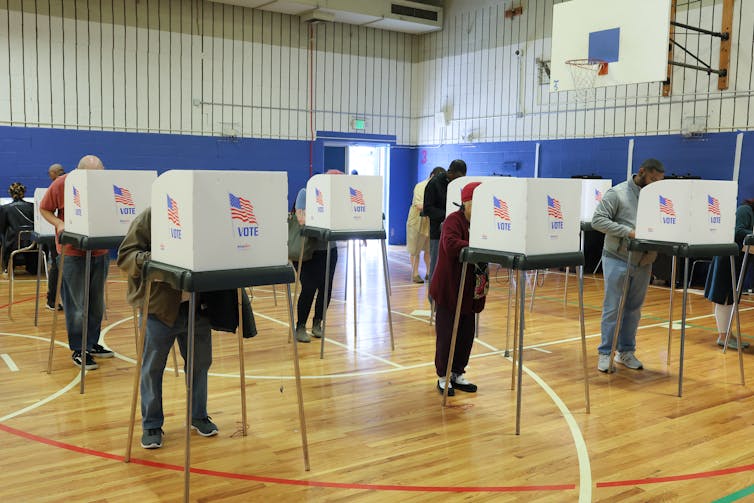
wildpixel/iStock via Getty Images
Ian Anson, University of Maryland, Baltimore County
With the 2024 U.S. election over and done with, political analysts and both major parties are already turning their attention to the upcoming midterm elections in 2026.
All 435 seats in the House of Representatives and 33 Senate seats will be up for grabs. The Democrats are as desperate to retake control of Congress as Republicans are to keep it. A Democratic-controlled Congress in 2026 would do everything in its power to halt President Donald Trump’s legislative agenda in its tracks.
To edge out their opponent, candidates in highly competitive districts will have to win over some voters who rejected their own party’s presidential candidate in 2024. Democratic candidates will need to get support from at least some Trump voters; Republicans will need some support from Kamala Harris voters.
Despite the intensely polarized U.S. political environment, a significant number of Americans routinely cross party lines to support both Democratic and Republican candidates at the polls. When it happens on the same ballot, this is called ticket-splitting.
Just who are these voters, and when do they choose to split their tickets?
I am a political scientist who studies American voting behavior. I see these questions as key to understanding how long Trump’s total control of government will last.
Split tickets in North Carolina and Arizona
Ticket-splitting created some surprising election returns in 2024, mostly benefiting down-ballot Democrats.
For instance, Republican Donald Trump won North Carolina by around 3 percentage points, but voters elected a Democrat, Josh Stein, for governor by a margin of almost 15 percentage points. Several hundred thousand North Carolinians split their tickets to produce this outcome.
More than 100,000 Arizonans likewise split their tickets in 2024, electing Trump with 52% of the vote, yet rejecting the Trump-aligned Senate candidate Kari Lake in favor of Democrat Ruben Gallego.
Many experts believe that candidates such as Gallego and Stein were simply perceived as less extreme than their opponents, and so they lured moderate voters and even some Republicans.
In this theory, extreme MAGA-aligned candidates win primary elections because they attract the most partisan voters. But they turn off many people in the general electorate.
Marylanders split their tickets
One of the most extreme examples of ticket-splitting in 2024 was in the race to replace U.S. Sen. Ben Cardin of Maryland.

J. Countess/Getty Images
Cardin was a retiring three-term Democrat who had last won reelection in 2018 by an astronomical margin of over 34 percentage points. Initially, many expert analysts saw the seat as safe for Democrats.
Then, in February 2024, former Maryland Gov. Larry Hogan, who had previously ruled out a Senate run, surprised political analysts by entering the Republican primary. After winning the primary handily, Hogan eventually squared off against Prince George’s County Executive Angela Alsobrooks, a Democrat, in the general election.
Suddenly, a matchup that should have been Alsobrook’s to lose got competitive.
Hogan, who left office in 2023, was a successful Republican governor who won election twice in reliably blue Maryland. Perceived by many voters as an ideological moderate, he was also a vocal Trump opponent in a state that supported Biden over Trump in 2020 by around 33 percentage points. During his governorship, Hogan routinely outperformed MAGA-aligned Republicans who ran for Congress in Maryland.
Ultimately, Hogan did lose to Alsobrooks. She became Maryland’s first female U.S. senator and first Black U.S. senator. Yet Hogan came an incredible 17 percentage points closer to winning than Trump did. Kamala Harris beat Trump by 1.9 million votes, winning 63% of the electorate to Trump’s 34%.
This means that Hogan exceeded Trump’s vote total by over 300,000 votes. That’s an immense amount of ticket-splitting by Marylanders in 2024.
Who are the Hogan Democrats?
To better understand ticket-splitting in Maryland’s 2024 election, I analyzed a survey that my university conducted in Baltimore County. Baltimore County is a bellwether county that has backed the winning gubernatorial candidate in every election since 2006.
The UMBC Battleground Exit Poll surveyed 1,119 voters at election precincts across Baltimore County during early voting and on Election Day 2024. The results were weighted to ensure demographic representativeness.
This extensive survey shows that around 10% of all voters in Baltimore County supported the surprising combination of the Democrat Harris and the Republican Hogan.
In contrast, fewer than 2% of Trump voters split their tickets to back the Democratic Senate candidate Alsobrooks.
My team’s data analysis shows that roughly half of Harris-Hogan voters – 51% – were Democrats. These ticket-splitters included a higher percentage of white voters than the Democrats who supported both Harris and Alsobrooks. Around 37% of Harris-Hogan voters identified as Black, Asian, Hispanic, Middle Eastern or another nonwhite racial category, compared with 55% of Harris-Alsobrooks voters.
We found virtually no gender differences between Democrats who split their tickets to back a woman for president and a man for Senate and those who backed two women candidates.
Harris-Hogan Democrats tended to be better educated than other voting groups. Around 68% reported having a college degree, compared with around 51% of all survey respondents.
Perhaps the most striking feature of Harris-Hogan voters is their self-declared moderation.
On a seven-point ideological scale ranging from “very liberal” to “very conservative,” around 61% of Harris-Hogan ticket-splitters put themselves at the exact midpoint of the scale. Only around 42% of the full sample of Maryland voters categorized themselves as centrist.
Can moderates survive in Trump’s shadow?
As our study shows, Hogan’s popularity in Maryland is due in part to his appeal among moderates. This finding helps to explain how this Republican has remained popular among Democrats and independent voters.
However, Hogan still lost. Unlike in Arizona, where the Democratic Senate candidate Ruben Gallego won by wooing moderate Republicans, the tenuous balance of power in the U.S. House and Senate may have prevented some Democratic and independent voters in Maryland from crossing the aisle to support a moderate Republican.
Of course, Hogan also faced a formidable opponent. Alsobrooks had already emerged victorious in a tight primary against a well-funded and popular incumbent U.S. House representative, David Trone. I suspect a less-skilled Democratic candidate would have created even more Harris-Hogan voters.
Ultimately, my analysis of ticket-splitting in 2024 reveals that even in an era of entrenched polarization, many voters approach congressional and presidential races with different mindsets.
This dynamic will likely influence the next election cycle, too.
The party of the president often takes heavy losses in midterm elections. In 2026, congressional candidates – and Democrats in particular – will be doing everything they can to woo moderates.
This will be especially true if Trump’s aggressive policies, such as widespread government layoffs and mass deportations, prove unpopular.
Let the campaigning begin.
Ian Anson, Associate Professor of Political Science, University of Maryland, Baltimore County
This article is republished from The Conversation under a Creative Commons license. Read the original article.



















































